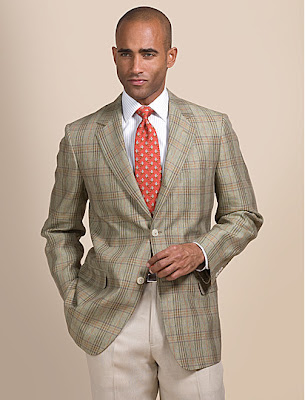Sport coats are the essential transitional garment in any man's wardrobe. Someone who thinks they may never have need of a traditional suit can quite often find themselves in want of a decent sport coat. A sport coat is probably the most versatile piece in one's closet. It can dress up jeans and sneakers, or dress down slacks and a tie. It can take it's wearer from a business meeting, to a bar, to a casual event, and back again, with nothing more than a slight adjustment to the undershirt.
Sport coats traditionally have a few qualities that set them apart from a suit jacket – most noticeably, they typically do not come with a set of matching slacks. Sport coats are not just the traditional blue blazer that has been a mainstay of yacht clubs and alumni events for generations. They have evolved into a sleeker, transitional design that can bring together an outfit. Typically they have “shank” buttons – buttons that attach to the coat through a loop on their back rather than being sewn on through holes in the button, like on suit coats. Sometimes these can have crests or logos on them (for more personalization) and while traditionally done in bronze or gold colors, they are available in more subdued designs for the less garish among us. Another characteristic of a sport coat is a “Patch” pocket – or a pocket that is sewn onto the coat, rather than cut into it like found on suits. These can also be slanted to the outside, something the British call a “Hacking” pocket that is not typically found on a suit jacket. Another quintessential British characteristic to the coat would be leather reinforced elbows. These are less common these days, and I think lean far more to the casual side – really putting the “sport” into a sport coat. These are all just examples, and while any of these would immediately identify a jacket as a sport coat, none are required for it to be classified as such.
| The ubiquitous Navy Blazer and a plaid sportcoat best worn with khakis or dark slacks |
As far as how to wear a sport coat, that is entirely dependent upon both the wearer, and the occasion. Like a suit jacket, the bottom button, whether with a two or three button jacket, should always be opened, and while I very rarely open all the buttons on my suit, this is far more appropriate while wearing the more casual sport coat.
I personally think that sport coats are best when paired with slacks or khakis and decent shoes. Blue is a good go-to color, but there are many options to go through – just remember to keep your basic style rules in place. No mixing browns and blacks, shoes must match with belt and socks (you'd be surprised how often this is overlooked) etc. Depending on the weather, they can be worn with a vest or a sweater underneath, and typically a dress shirt. A tie is purely dependent on personal preference and the formality of the occasion.
 |
| An example of how a sport coat can be a very elegant business look. Take away the tie, add jeans and boat shoes, and you have a classy but still casual feel. |
A sport coat with jeans can be great for casual Fridays, or any casual occasion where one just cannot bring themselves to wear a t-shirt or a hoodie – and again, these are more common than one might initially think. Street shoes or deck / boat shoes are an excellent choice with this look – especially if matched with the coat. If worn with a t-shirt of sweatshirt, make sure it is a solid color, or something unobtrusive. Your swagger should make the statement, not the logo.
On more formal occasions, even those without a tie, a pocket square can be an interesting addition. While in a suit I typically like clean, smooth lines, and keep mine squared off over the pocket, but in a sport coat, you can get away with far more interesting colors and styles. Try a peaked fold, or have the edges splayed out of the pocket. This works especially well with a bordered pocket square.
If you are still building your wardrobe, start off with something blue – it can go with everything, and can easily be built upon, but don't shirk the idea of a gray or tan coat. The more you use them the more you will find ways they are useful. Don't get caught up with one look or style. Experiment and play around with it, and it helps to keep your options open. Like I have always been told, “if all you have is a hammer, everything looks like a nail.” This old adage can be applied to everything from tools to tactics to fashion. Use what you have, but don't become too attached to your methods.
| Sportcoat and hoodie? Don't be that guy. Seriously, you're better than that. |

Informative post !!! click here for More Best Slim Suits for Mens in USA thanks .......
ReplyDelete